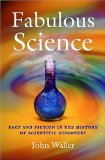 Fabulous Science: Fact and Fiction in the History of Scientific Discovery
Fabulous Science: Fact and Fiction in the History of Scientific Discovery
by John Waller
Oxford University Press, £8.99 (pb), ISBN 0198609396
Waller’s main theme is our predilection to glamourise, embellish and invent, giving case studies showing that even in science there can be a gap between myth and reality and nothing should be taken at face value. He sets about the great names with vigour, and suggests the useful term “presentism” for our inability to separate our view of the past from our present knowledge, so that in retrospect what happened seems obvious and inevitable and its proponents always brave battlers against ignorant opposition.
Waller spends time telling us things most people interested in the history of science will already know, such as that to say Darwin originated the idea of evolution is grossly oversimplified, and Huxley’s account of defending him against Bishop Wilberforce exaggerated, but his revelations about Pasteur, Eddington, John Snow (he didn’t remove that famous pump handle), Mendel, Lister, Banting and Best, and Fleming (perhaps the classic example of how one name predominates) are interesting. However, I was saddened by Waller’s statement that Sir Cyril Burt was “exposed as an academic fraud.” He adds that the case is unproven but makes no mention of the evidence that he was largely innocent. It’s a passing remark, but casts doubt on Waller’s thoroughness. And for someone concerned to demolish myths it’s odd that he should apparently give credence to the story of Galileo and the Leaning Tower of Pisa.
For a book from probably the most reputable publisher in the world this one has a remarkable number of blunders: the “Queensbury rules” (Queensberry), “loathe” (loath), “effect” (affect), “over-weaning” (overweening), and in the index “Tennyson, Lord Alfred” (Tennyson, Alfred, Lord). Gwyn Macfarlane and Leslie Macfarlane are in the index as being on the same page (Leslie is in fact elsewhere), and several important names (Macleod, Collip, and Banting) are missing completely. This is an interesting book and a salutary lesson in not taking even seemingly authoritative works at face value if the authors haven’t gone to the original sources.
Ray Ward

